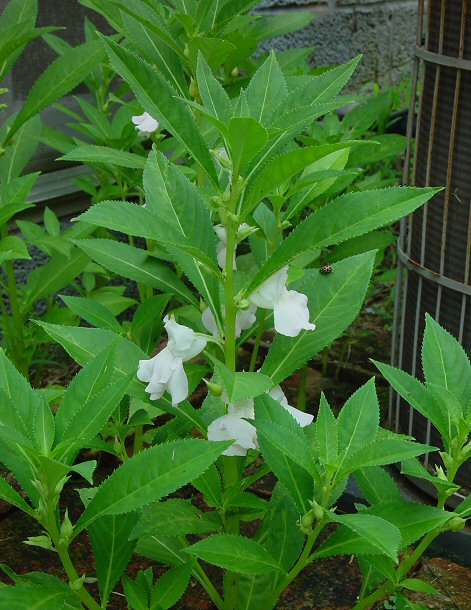Impatiens balsamina L.
Balsam

Introduced
CC = *
CW = 5
MOC = 2
© DETenaglia
Impatiens balsamina L.Balsam | |
 |
Introduced CC = * CW = 5 MOC = 2 |
© DETenaglia |
|
Family - Balsaminaceae Habit - Annual forb. Young plants pubescent with short, curved, somewhat glandular hairs.
Stems - Ascending to erect, to 80 cm.
Leaves - Alternate, simple, short-petiolate, 3-10 cm long, the blade oblanceolate to narrowly elliptic, tapered gradually at the base, tapered to the sharply pointed tip, the margins sharply and finely toothed, the basal portion and petiole usually with several small, hemispheric to stalked or tack-shaped, dark-colored glands.
Inflorescence - Solitary or less commonly pairs of axillary flowers, these purple to red, pink, white, or combinations thereof. Flowers - Spurred sepal with the pouched portion 6-14 mm long, broadly conical, wider than long, the spur 1.3-2.2 cm long, gradually recurved.
Fruits - Fruits 1.2-2.0 cm long, asymmetrically elliptic in outline. Seeds 2.5-4.0 mm long, oblong-ovate in outline, rounded at the tip, bluntly 4-angled, the surface pebbled to finely warty, dark brown, with minute, lighter flecks. Flowering - July - September. Habitat - Railroads, creek beds, and moist, disturbed areas, usually escaped or persisting from cultivation. Origin - Native to Asia. Lookalikes - None. Other info. - This striking species is rare in the wilds of Missouri, thus far reported from only two counties. Its wider range in the continental U.S. is similarly widely scattered and sporadic in the eastern half of the country. The plant can have flowers of various colors. Photographs taken in Vale, NC., 8-23-03 (DETenaglia); also in the bed of Fox Creek, St. Louis County, MO, 7-13-2012 (SRTurner). |